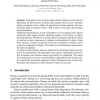Free Online Productivity Tools
i2Speak
i2Symbol
i2OCR
iTex2Img
iWeb2Print
iWeb2Shot
i2Type
iPdf2Split
iPdf2Merge
i2Bopomofo
i2Arabic
i2Style
i2Image
i2PDF
iLatex2Rtf
Sci2ools
ICEIS
2010
IEEE
2010
IEEE
Pattern Recognition as a Human Centered non-Euclidean Problem
Regularities in the world are human defined. Patterns in the observed phenomena are there because we define and recognize them as such. Automatic pattern recognition tries to bridge the gap between human judgment and measurements made by artificial sensors. This is done in two steps: representation and generalization. Traditional representations of real world objects to be recognized, like features and pixels, either neglect possibly significant aspects of the objects, or neglect their dependencies. We therefor reconsider human recognition and observe that it is based on our direct experience of similarity or dissimilarity of objects. Using these concepts, a pattern recognition system can be defined in a natural way by a pairwise comparison of objects. This results in the dissimilarity representation for pattern recognition. An analysis of dissimilarity measures optimized for performance shows that they tend to be non-Euclidean. The Euclidean vector spaces, traditionally used in patter...
Related Content
| Added | 12 Feb 2011 |
| Updated | 12 Feb 2011 |
| Type | Journal |
| Year | 2010 |
| Where | ICEIS |
| Authors | Robert P. W. Duin |
Comments (0)

